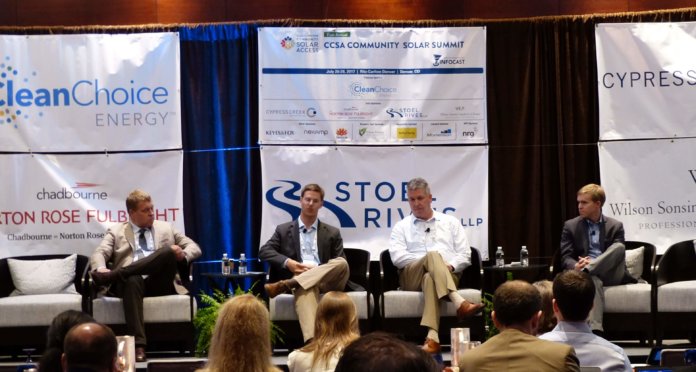The U.S. solar industry held its first conference dedicated solely to community solar in Denver last week, signifying the impressive progress this segment of the market has made in only a few short years. The Community Solar Summit brought together developers, financiers, asset owners, and utilities to discuss how far community solar has come and assess the way forward through 2017 and beyond.
Overall, there was a shared sense of optimism from participants about community solar’s near-term future and the prospects of achieving the model’s multi-gigawatt potential. However, there is still much work to be done to advance the industry by community solar advocates, regulators and utilities alike. From my perspective, three key themes discussed during the conference will help the industry continue to flourish:
1. Define the Value of Community Solar
From a policy perspective, what we have not successfully done yet as an industry is argue for the true value of community solar. The “true value” is the value of generating power near the location that it will eventually be consumed. Local energy produced via community solar removes the transmission losses and eliminates distribution costs, among other benefits. Regulators and operators have not yet adopted a standard formulaic method that statistically proves these benefits, but they are there. Once there is an established formula proving some of these additional benefits, we can educate policymakers, utilities and customers on the true value of community solar.
2. Customer Benefits Should be Tangible, Collaborative
To achieve continued growth and robust customer support, community solar providers must design and offer programs that deliver an economic benefit for program participants to go along with the inherent environmental benefits from locally generated clean energy. Clean energy programs that require a cost premium are failing to achieve broad consumer adoption, central to the motives of regulators, financiers and developers.
Community solar providers must also design programs that deliver the value of clean energy generation in real time. Tools such as user-friendly engagement portals allow customers to see and experience community solar more directly, which improves engagement, retention and advocacy. Without thoughtful, continued engagement in the programs, customers will not receive the full benefit of active participation in the energy marketplace through community solar.
Online customer engagement portals should be leveraged to provide:
- Real-time energy production monitoring;
- Bill savings reports;
- Environmental benefits, such as carbon offset;
- Community solar updates and account messaging; and
- Sharable information, such as environmental benefits, that is viewable across platforms.
3. The Importance of Good Policy
Just as important, if not more so, is that collectively as an industry, continued advocacy of good policy is vital. Good policy isn’t just about enabling community solar; it’s about enabling community solar in the right way and ensuring we have a common policy objective.
For example, the Community Distributed Generation program in New York has the potential to be a very good program, but it has thus far been limited by the low value of credits in some locations, the high interconnection costs and long lead times, and the slow policy process. Ensuring faster interconnection and more responsive policy is one way to ensure the community solar industry will remain responsive and robust in the years to come.
What’s Next?
By year’s end, GTM research indicates more than 400 MW of community solar will be installed in the U.S. – up from 1 MW of installed community solar in 2010. The first Community Solar Summit provided a great opportunity to discuss the industry’s growth potential, as well as current challenges facing the industry.
As community solar continues to evolve, there are plentiful sources of capital and widespread interest around the country that are driving development under new policies either requiring or enabling community solar. To help the community solar industry continue to flourish, defining the value of solar, clearly communicating tangible economic benefits with customers, and being dedicated stewards of good policy will be of vital importance in the months to come.
Let’s strive to create policy that makes it easier to enable community solar, and let’s work together to create community solar policy across the nation.
Tom Hunt is vice president of corporate development and chief of staff for Clean Energy Collective (CEC), where he leads the community solar company’s development of new products, policy efforts and regulatory involvement.
Photo courtesy of CEC: Hunt (far right) joined other panelists on stage to speak during a session at last week’s Community Solar Summit.




